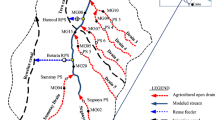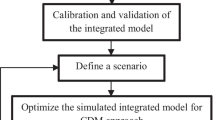Abstract
The scarcity of water resources in Egypt has necessitated the use of various types of lower quality water. Agricultural drainage water is considered a strategic reserve for meeting increasing freshwater demands. In this study, a novel model series was applied to a drainage basin in the Nile Delta to optimize integrated water quality management for agriculture and the aquatic environment. The proposed model series includes a waste load allocation model, an export coefficient model, a stream water quality model, and a genetic algorithm. This model series offers an optimized solution for determining the required removal levels of total suspended solids (TSS), the chemical oxygen demand (COD) at point and non-point pollution sources, and the source flows that require treatment to meet a given water quality target. The model series was applied during the summer and winter to the El-Qalaa basin in the western delta of the Nile River. Increased pollutant removal and treated fractions at point and non-point sources reduced violations of the TSS standards from 732.6 to 238.9 mg/L in summer and from 543.1 to 380.9 mg/L in winter. Likewise, violations of the COD standards decreased from 112.4 mg/L to 0 (no violations) in summer and from 91.7 mg/L to no violations in winter. Thus, this model is recommended as a decision support tool for determining a desirable waste load allocation solution from a trade-off curve considering costs and the degree of compliance with water quality standards.











Similar content being viewed by others
References
Abulnour AG, Sorour MH, Talaat HA (2002) Comparative economics for desalting of agricultural drainage water (ADW). Desalination 152:353–357
Brown LC, Barnwell TOJ (1987) The enhanced stream water quality models QUAL2E and QUAL2E-UNCAS: documentation and user manual. US EPA, Environmental Research Laboratory, Athens, GA, EPA/600/3-87/007
Burn DH, Yuliant S (2001) Waste-load allocation using genetic algorithms. J Water Resour Plan Manag (ASCE) 127(2):121–129
Chow VT, Maidment DR, Mays LV (1988) Applied hydrology. McGraw Hill, New York, 592 pp
Covar AP (1976) Selecting the proper reaeration coefficient for use in water quality models. Presented at the US EPA Conference on Environmental Simulation and Modeling, April 19–22, Cincinnati, OH
DRI (Drainage Research Institute) (2007) Drainage water status in the Nile Delta year book 2005/2006. Technical Report No. 76, DRI, NWRC, Egypt
Drolc A, Konkan JZZ (1996) Water quality modeling of the River Sava, Slovenia. Water Res 30(11):2587–2592
El-Sheikh MA, Hazem IS, Diaa EE, Abdallah AM (2010) Improving water quality in polluted drains with free water surface constructed wetlands. Ecol Eng 36:1478–1484
Fleifle A, Tawfik A, Saavedra OC, Yoshimura C, Elzeir M (2013) Modeling and profile analysis of a down-flow hanging sponge system treating agricultural drainage water. Sep Purif Technol 116:87–94
Gao J, Liu Y (2010) Determination of land degradation causes in Tongyu County, northeast China via land cover change detection
Johnes PJ (1996) Evaluation and management of the impact of landuse change to the nitrogen and phosphorus load delivered to surface waters: the export coefficient modelling approach. J Hydrol 183:323–349
Kannel PR, Lee S, Lee YS, Kanel SR, Pelletier GJ (2007) Application of automated QUAL2Kw for water quality modeling and management in the Bagmati River, Nepal. Ecol Model 202:503–517
Karamouz M, Kerachian R, Mahmoodian M (2003) Seasonal waste-load allocation model for river water quality management. Proceedings of World Water and Environmental Resources Congress, Philadelphia, USA
Kerachian R, Karamouz M (2005) Waste load allocation model for seasonal river water quality management application of sequential dynamic genetic algorithms. Sci Iran 12(2):117–130
Khalil B, Ouarda TBMJ, St-Hilaire A, Chebana F (2010) A statistical approach for the rationalization of water quality indicators in surface water quality monitoring networks. J Hydrol 386:173–185
Leica Geosystems (2008) Leica geosystems geospatial imaging ERDAS IMAGINE 9.2. Leica Geosystems Geospatial Imaging, Norcross, GA
MAB (1983) Law 48/1982 regarding the protection of the River Nile and waterways from pollution. MAB National Committee, Egypt
Metcalf & Eddy Inc. (2003) Wastewater engineering: treatment and reuse, 4th edn. McGraw-Hill, New York
Mostafavi SA, Afshar A (2011) Waste load allocation using non-dominated archiving multi-colony ant algorithm. Proced Comp Sci 3:64–69
Mujumdar PP, Sasikumar K (2002) A fuzzy risk approach for seasonal water quality management of a river system. Water Resour Res 38(1):5-1–5-9
Mujumdar PP, Vemula VRS (2004) Fuzzy waste load allocation model: simulation–optimization approach. J Comput Civil Eng (ASCE) 120:120–131
Ng AWM, Perera BJC (2003) Selection of genetic algorithm operators for river water quality model calibration. Eng Appl Artif Intell 16(5–6):529–541
Park SS, Uchrin CG (1990) Water quality modeling of the lower south branch of the Raritan River, New Jersey. Bull NJ Acad Sci 35(1):17–23
Park SS, Lee YS (1996) A multiconstituent moving segment model for the water quality predictions in steep and shallow streams. Ecol Model 89:121–131
Pelletier GJ, Chapra SC (2005) QUAL2Kw theory and documentation (version 5.1). A modeling framework for simulating river and stream water quality. Retrieved 10 May 2005 from http://www.ecy.wa.gov/programs/eap/models/
Pelletier GJ, Chapra CS, Tao H (2006) QUAL2Kw—a framework for modeling water quality in streams and rivers using a genetic algorithm for calibration. Environ Model Softw 21:419–4125
ReVelle C, McGarity AE (1997) Design and operation of civil and environmental engineering systems. Wiley, New York, 10158-0012
Ritzel BJ, Eheart JW, Ranjithan S (1994) Using genetic algorithms to solve a multiple objective ground water pollution problem. Water Resour Res 30(5):1589–1160
Saadatpour M, Afshar A (2007) Waste load allocation modeling with fuzzy goals; simulation–optimization approach. Water Resour Manag 21(7):1207–1224
Saavedra VO, Koike T, Yang K, Yang D (2010) Optimal dam operation during flood season using a distributed hydrological model and a heuristic algorithm. J Hydrol Eng ASCE 15(7):580–586
Shaban M, Urban B, ElSaadi A, Faisal M (2010) Detection and mapping of water pollution variation in the Nile Delta using multivariate clustering and GIS techniques. J Environ Manag 91:1785–1793
Suresh HR, Mujumdar PP (1999) A neural network model for waste load allocation in rivers. Proceedings of the Civil and Environmental Engineering Conference: New Frontiers and Challenges, Asian Institute of Technoloy, Bangkok, Thailand 1(2):97–104
Shrestha S, Kazama F, Newham LTH (2008) A framework for estimating pollutant export coefficients from long-term in-stream water quality monitoring data. Environ Model Softw 23:182–194
Talaat HK, Sorour MH, Rahman NA, Shaalan HF (2002) Pretreatment of agricultural drainage water (ADW) for large-scale desalination. Desalination 152:299–305
US EPA (US Environmental Protection Agency) (1985) Screening procedure for toxic and conventional pollutants in surface and ground water. EPA/600/6-85/002. US Environmental Protection Agency, Athens
US EPA (US Environmental Protection Agency) (1992) Managing nonpoint source pollution. EPA-506/9-90. US Environmental Protection Agency, Office of Water, Washington, DC
WHO (World Health Organization) (2002) Environmental Health Eastern Mediterranean Regional, Center for Environmental Health Activities (CEHA)
Yandamuri SR, Srinivasan K, Bhallamudi MS (2006) Multi-objective optimal waste load allocation models for rivers using non-dominated sorting genetic algorithm—II. J Water Resour Plan Manage 132(3):133–143
Yassuda EA, Davie SR, Mendelsohn DL, Isajic T, Peene SJ (2000) Development of a waste load allocation model for the Charleston Harbor estuary, phase II: water quality. Estuar Coast Shelf Sci 50:99–107
Acknowledgments
The first author is very grateful to the Ministry of Higher Education (MOHE) for providing financial support for this research.
Author information
Authors and Affiliations
Corresponding author
Additional information
Responsible editor: Michael Matthies
Rights and permissions
About this article
Cite this article
Fleifle, A., Saavedra, O., Yoshimura, C. et al. Optimization of integrated water quality management for agricultural efficiency and environmental conservation. Environ Sci Pollut Res 21, 8095–8111 (2014). https://doi.org/10.1007/s11356-014-2712-3
Received:
Accepted:
Published:
Issue Date:
DOI: https://doi.org/10.1007/s11356-014-2712-3




